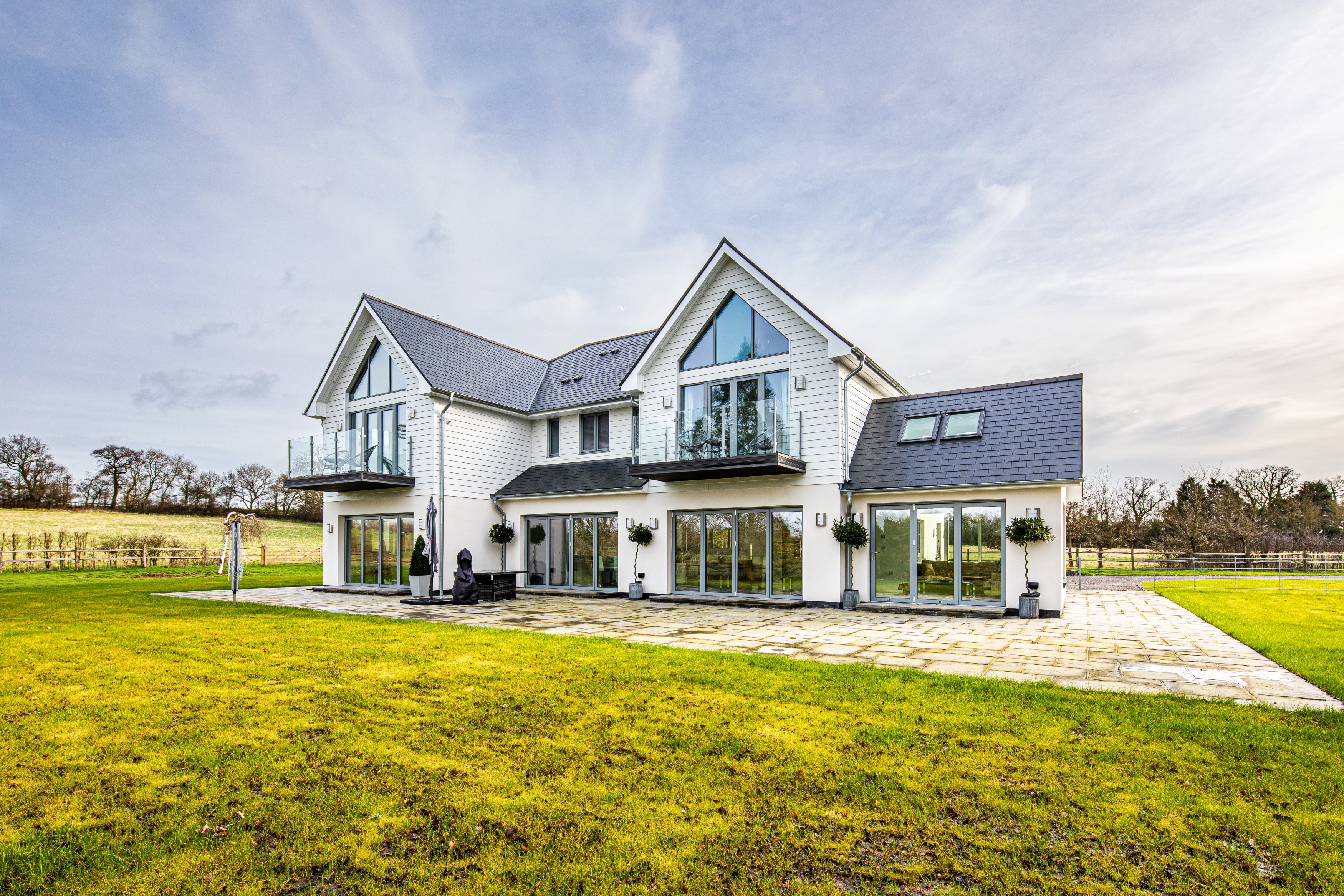The lowdown on U-values
As a measure of the thermal efficiency of a material, it is important to get to grips with U-values when building a home and when choosing your windows and doors.
We answer your most frequently asked questions and look in depth at why they matter.
Low U-value windows
Norrsken are providers of the finest quality timber and alu-clad timber windows and doors. Our windows range includes double and triple-glazed windows, as well as entrance doors, french doors, sliding and folding doors.
We are passionate about our products and our customers, helping to create fabulous, energy-efficient homes across the UK.
Many of our products are suitable for use in Passive Houses, and our expert team provides end-to-end support to ensure your project runs smoothly from start to finish.
To compare products quickly and access technical information, try our selector tools below.
-
Our Window Selector
Premium design, precision engineering -
Our Door Selector
High performance insulated entryways
Inspiration for your project
GALLERY

What are U-values?
In a phrase, U-values are a measure of heat loss through a material. They’re used to measure how effective elements of a building's fabric are as insulators; that is, how effective they are at preventing heat from transmitting from the inside to the outside of a building.
The more effectively insulated a structure is, the lower (and better) the U-value will be. They are measured in watts per square metre per Kelvin* (W/m²K).
U-values can be calculated for any building material. This allows effective, standardised comparison of all the component parts of your structure based on their thermal performance. This in turn allows you to catch the areas heat will be lost, eliminate poor insulators and achieve the best overall level of thermal efficiency for your project.

How are U-values calculated?
U-values are calculated by summing all the thermal resistances (the R-values) in the materials of the target component, and finding the reciprocal of that total.
Thermal resistance is a measure of the material’s insulation capacity, calculated by dividing the thickness of the material by its thermal conductivity (k-value).

What are good U-values for windows?
Current building regulations state that windows in a new-build house must have a U-value of 1.2 W/m²K or better(1.4W/m²K or better for replacements).
Modern double-glazed units use Low Emissivity Glass (Low-E) and argon or krypton gas in the cavity and the best double-glazed windows can achieve a U-value in the region of 1.2 W/m²K. By contrast, triple-glazed windows can have a U-value of less than 0.8 W/(m²K) – 50% better than the best double-glazed windows.
Triple-glazed windows are growing in popularity, and are projected to be one of our top trends to watch in windows for 2025.
Which windows are right for you?
Take our short survey to discover the perfect windows for your project.
Your questions answered
Have a question? You’re not alone. We’ve answered some of the most common queries about U-values below.
Collapsible content

What difference does glazing type make?
Our highest-performing triple-glazed windows have U-values as low as 0.64W/m²K. Two panes of heat reflective Low-E glass per window allow warming infra-red rays into your home but reflect heat back into the room that would otherwise be lost to the outside.
A single-glazed window has a U-value of around 5.0 – meaning it loses around 8 times more heat than our best triple-glazed window; a difference that really does matter. In most houses, 20-25% of heat is lost though windows and doors – so 75% of heat loss originates from other elements of a structure.
The best way to maximise the performance of your windows and doors is by adopting a holistic approach to the thermal envelope – by which we mean the walls, floor, roof, windows, doors, roof windows and roof lights - of your building. That said, investing in windows with low U-values will still have a drastic impact on the thermal efficiency - and comfort- of your home – you are effectively targeting up to a quarter of all heat lost.
Have a read of the Performance page on our website to learn about five of the key factors that make a thermally efficient window.
What about Passive House requirements?
The International Passive House Association describes the Passive House Standard as “the only internationally recognised, performance-based energy standard in construction”.
To become Passive House certified, a new building must meet strict requirements in its thermal insulation, windows, ventilation heat recovery, airtightness and thermal bridging control specification. The end goal is to create a comfortable, affordable and impressively low-energy building.
For a window to meet Passive House requirements, the entire unit, i.e. glazing and frame, should have a U-value of 0.80W/(m²K) or less – a specification easily met by most of our triple glazed range.
For more information on the Passive House standard and its history, read this article.
Are triple-glazed windows right for you?
Triple glazing provides homeowners a marked increase – 40-45% - in thermal performance from double glazed alternatives, meaning greater comfort, lower heating bills, and an uplift in property value.
These windows and doors are durable, secure and aesthetically pleasing - and they're not just for Passive Houses, either. When choosing your windows and doors, though, you should take into account your whole-building thermal efficiency, budget, and noise concerns to make an informed decision.
High performance double glazing can provide a useful alternatives to those considering triple glazing who feel it doesn’t suit their project requirements.
When you choose alu-clad timber triple-glazed windows and doors, you benefit from the charm and warmth of wood and the sleek, low maintenance needs of aluminium.
Norrsken double and triple-glazed windows are engineered for exceptional thermal performance, keeping your home comfortable and energy-efficient year-round.
What are U-values?
U-values are a measure of heat transfer through a material. They are used to evaluate the effectiveness of building components as insulators.
The more effectively insulated a structure is, the lower (and better) the U-value will be. They are measured in watts per square metre per degree Kelvin (W/m²K).
How are U-values calculated?
U-values are calculated by summing all the thermal resistances (the R-values) in the materials of the target component, and finding the reciprocal of that total.
Thermal resistance is a measure of the material’s insulation capacity, calculated by dividing the thickness of the material by its thermal conductivity (k-value).
What's a good U-value for windows?
UK Building Regulations require windows to achieve a U-value of 1.2W/m²K or lower. The best double glazing can achieve around 1.2 W/m²K.
Passive House windows must achieve 0.80W/m²K or lower. Our highest performing triple-glazed windows achieve 0.64W/m²K for exceptional insulation, warmth and comfort.
What is the U-value of double glazing?
Double glazed windows generally achieve U-values ranging from 1.2 - 3.0W/m²K.
Our double glazing ranges from 1.24 -1.29 W/m²K approximately, sitting on the highest end of the double glazing performance spectrum and well within UK Building Regulation requirements for windows.
What is the U-value of triple glazing?
Most triple-glazed windows have a U-value less than 1 W/m²K.
Our triple-glazed windows range from 0.64-0.94 W/m²K, and several models are suitable for use in Passivhaus and ultra low-energy projects with exceptional U-value performance of under 0.80 W/m²K.
U-value vs R-value
Thermal resistance (denoted by an’ R-value’) is a measure of the heat insulation capacity of a material.
R-values measure how much heat is preserved across its thickness, whereas the U-value is how much it loses per square metre across a 1 degree temperature difference between the inside and outside surfaces.
What is the U-value of glass?
Sometimes called the centre pane U-value or Ug-value, the U-value of a glass package depends on several factors:
whether it is double or triple-glazed, the spaces between glass panes, the insulating gas used and the thickness of the glass panes.
Because it is measured away from the edges of the window where more heat is lost, it is usually lower than the whole window U-value.
What U-value is a Passive House ?
Thermal insulation is usually considered the most important requirement in the design and building process of a Passive House.
All opaque surfaces of a building must have u-values of 0.15 W/(m²K) or less. Passive House windows must achieve 0.80 W/m²K or less to meet the requirements.
Are U-values the same as thermal conductivity?
No. U-value = 1 / (R0 + R1 + …. + Rn), the reciprocal of the sum of all the requisite R-values in a component.
The R-value of each material = thickness of the material / conductivity of the material. So the U-value = thermal conductivity / thickness, averaged out across all the materials in a component.
What U-values are required for the Building Regulations?
U-values can be calculated for any building material. This allows effective, standardised comparison of all the component parts of your structure based on their thermal performance.
This in turn allows you to catch the areas heat will be lost, eliminate poor insulators, and achieve the best overall level of thermal efficiency for your project.
Building Regulations
Read our guidance on UK Building Regulations below.
This information is not a replacement for the Building Regulations themselves but provides a quick and easy-to-read overview of relevant Building Regulations for windows and doors for Architects and includes helpful diagrams, flowcharts and explanations to help you navigate the regulations.
-
The Future Homes Standard
The Future Homes Standard aims to slash carbon emissions by 75-80% in new homes from 2025 with fabric-efficient building and low-carbon heating systems. Read about it below. -
Part O: Overheating & Solar Gain
Part O aims to reduce unwanted solar gains in new buildings. It contains approaches to limit solar gains and ventilation methods to remove excess heat. Read the regulations below. -
Part F: Ventilation & Trickle Vents
Part F governs ventilation requirements in new and existing buildings. It was updated in 2022 to increase ventilation provisions. Learn what it means for you below. -
Part L: Energy Efficency
Part L governs the energy efficiency of buildings. It was updated in 2022 as a stepping stone to the Future Homes Standard. Read the latest regulations below.
Unmistakably trusted.
The highest compliment is a recommendation. These are the voices of those who placed their trust in us.











